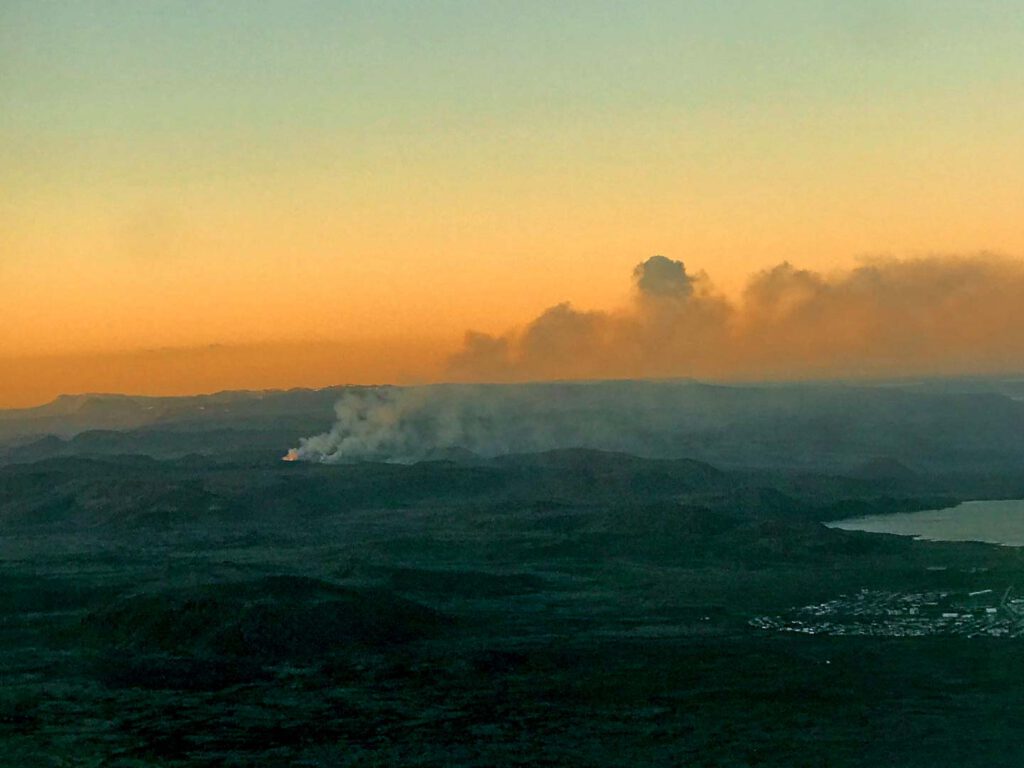The entry formalities and the corona test took some time, so I wasn't at the accommodation until 2 a.m. Time to walk past sleepy Icelandic horses to the nearby beach and see the approaching sunrise.
The next day I first explored the outer tip of Reykjanes (“Smoke Tip”). There is a bridge there that stretches from Europe to America - more precisely between the tectonic plates of these continents that meet here. I found it less impressive there than the Allmänner gorge at Thingvellir, which also separates the continents.
A little further south you will pass a rather inconspicuous crater called Stampar. But it is worth climbing up and marveling at the archaic lunar landscape. Incidentally, the large broken area on my second photo was not easy to find after walking down.
From there you can already see an industrially used geothermal area with hissing steam springs. But there is also an impressive hot water spring called Gunnuhver, which, with its steam and a large fountain of boiling water, seriously competes with the famous Strokkur geyser. A bridge that once existed there could not withstand the force of nature.
On the south coast with its lava rocks there are naturally formed pools of water, of which the Brimketill is best known. They look like hot tubs, but it's icy sea water. My photo shows a basin that is near the Brimketill.
The journey continued via Grindavik near the active volcano on Fagradalsfjall. The mountain from which the volcano could be seen is now surrounded by lava on both sides and is no longer accessible. But you can go to the valley into which the lava flows. There, too, you have an impressive natural spectacle. On the surface the lava is only lukewarm, but you can see from the smoke that it looks different underneath. Depending on how long the volcano is still active, it is possible that the valley will be flooded and the lava will destroy the main connecting road to the coast.
A little further there is another geothermal area, Seltún at Krýsuvík. The weather wasn't inviting, but it made the area even more eerie than it already is.
On the way back I drove near the blue lagoon over a gravel road to the little-visited volcanic chain Eldvörp. They are only small cones, but they do not hide their volcanic origin.
Finally, of course, a visit to the blue lagoon was due. The drained water in the rugged lava field looks a bit surreal.
There are no impressive waterfalls on Reykjanes, and no glaciers either. Nevertheless, the small round trip was worth it, and I would recommend every Icelandic traveler to have a look around there. There is more to discover there.

7. November 2021 Author Mario A. Scarati
Noch einmal, habe ich mit extremem Interesse eine Foto Story von Herr Vorberg gelesen, und die entsprechenden Fotos nachgesehen. Alle Fotos dieser Fotochronik haben einen besonderen Charakter, und jedes Foto ergreift das Wesen dieser trostlosen und faszinierenden Orte. Ausserdem, ist zu bedenken die Schwierigkeit bei schlechten Wetterbedingungen diese kunstlerische Fotoarbeit zu machen.
Auch noch, ist die technische Beschreibung der verwendeten Fotoausrustung sehr komplett und interessant.
Mario S., Mailand
7. November 2021 Author ewald
Vielen lieben Dank, Mario!
Es freut mich immer, wenn meine Bilder geschätzt werden. Island ist so faszinierend, dass man gern tausend Bilder machen würde, aber wenn man sich auf das Wesentliche konzentriert kann man den Charakter der Landschaft besser vermitteln. Meist mache ich meine Landschaftsbilder ja mit der Hipstamatic – die kann sehr gut die Stimmung einfangen. In Farbe ist es etwas schwieriger, aber es geht auch.
Die Technik ist eigentlich ja nicht so wichtig, aber ich erfahre auch immer gern was wofür geeignet ist und gebe auch meine Erfahrungen gern weiter.
Herzlichen Dank nochmals für den Kommentar
Mit vielen Grüßen nach Mailand
Ewald